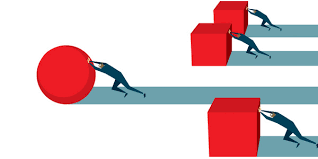The introduction
The present of our business is heading towards prosperity in order to succeed in proving its presence in today’s market. Therefore, the businessman who wants to open a company must be familiar with all the things that enhance the value of his entry into the labor market, which begins with the economic feasibility study
There are basic factors that make it easier for the business owner to enter strongly into the competitors market, which we will learn about in this article
It is considered one of the most powerful effective factors in the success of any project is to work on enhancing the competitive advantage in a correct and effective manner. When you do this, you will have business immunity and a share in the market in which you work, which increases the profit and sales of your company
Table of contents
What is the competitive advantage and its importance
What are the characteristics of competitive advantage and why do we use them
8 types of competitive advantages
The difference between competitiveness and competitive advantage
Four ways to gain a competitive advantage
What is the competitive advantage and its importance
It is a feature that allows the company to outperform its competitors, and it is either a new innovation or a discovery of new ways in manufacturing, marketing or development, and in everything that may lead to creating better added value than competitors (high quality product, modern technology, low price, fast service...)
The importance of competitive advantage
Reaching the appropriate competitive advantage is one of the most effective business strategies, just like marketing products, doing market studies and forecasting future sales. Therefore, the goal of using competitive advantage can be summarized as follows:
Increased sales and thus increased profits.
Giving a dynamic movement to the internal operations of the company, such as production and marketing
A step ahead of competitors, especially if the company can maintain the continuity of its competitive advantage and protect it from imitation
Raising the value of the company and its shares among investors, gaining their confidence, and increasing the value of the company in the media and among specialists
Increasing customer loyalty to the brand, you may be interested in learning about building digital marketing strategies
What are the characteristics of competitive advantage and why do we use them
There is a set of determinants of competitive advantage that will indicate if it is really an advantage or just an idea or tradition, etc. It is as follows
First, the ability to embody
If the competitive advantage is not applicable on the ground and full embodiment on the field, then it is useless and it should remain just future sayings and designs at the most, the arrival of a company to a new innovation will have a future and not today, because of the lack of infrastructure, for example, or the market is not ready and its customers, as an example of embodied competitive advantages
Providing raw materials in very large quantities
Hiring highly qualified staff and workers
Access to new technologies, innovation or import
Expansion into a very convenient geographic range
Second, effective and decisive
If the competitive advantage is not better than the competitors in the part it covers, it will be incomplete and will not achieve much for the company. The description of “competitiveness” clearly means creating a kind of competition and keeping pace with other companies active in the same field of the company
Third: exclusive and fortified
Of course, it is immoral to steal other people's ideas or to imitate them literally! In leaving no room for the company to show and highlight its personality and special touch, we do not mean here inspiration and taking advantage of competitors’ loopholes and developing them after studying competitors. Information technology, and the competitive advantage must not be easy to imitate and imitate by competitors, otherwise it will lose its immunity and secret
Fourth: It provides real added value
This part is for targeted customers, who are the center of competition and the mainstay of trade. Without creating a real added value that makes a difference to customers, competitive advantage does not make sense even if the previous conditions and characteristics are met! It is unreasonable for a company to gain a competitive advantage and outperform its competitors and dominate the market through it without achieving the slightest satisfaction of the needs and desires of customers
This added value may be entirely new or existing and developed, such as
Reducing prices with the quality of services without falling into a loss, but rather achieving more profit, whether financial or marketing
Providing new additional services that are not available to competitors, such as free delivery services
Fifth: Life Cycle and Continuity
Each competitive advantage has a life cycle that has a beginning, an upsurge, then a decline, and an end, and it is rare to find a long-lived competitive advantage these days, due to the availability of most companies on advanced technologies and the speed of developments in all fields, and the emergence of scientific studies and academic papers in an accelerated and periodic manner, which may make Any competitive advantage today is liable to disappear tomorrow! Only based on recommendations from a recent scientific study that advises this or that or because companies imitate each other, as happens with Chinese companies that no longer hesitate to imitate and steal the competitive advantages of American and European companies in broad daylight
Why do we use competitive advantage
Startups use the competitive advantage tool to help them get more value for their products at a lower price without losing their quality to offer better features and services

8 types of competitive advantages
There are a lot of different types of competitive advantages – consider what sets your competition apart before choosing which ones will give your business the best results
Choose a good location
Having a great website is a must if you are a retailer. Your competitive advantage may be the amount of foot traffic that passes through your store if you rent or own a building on the main shopping street
hiring employees
Hiring helpful, friendly, and proactive employees can be a huge competitive advantage for your business. Ensure your employees are well trained and motivated by
Use training programs to teach quality standards periodically
Existence of incentive plans
Encourage them to enhance their knowledge of the product or service
Products or Services
By sourcing products or services that your competitors cannot obtain, you will establish a uniqueness in your business
Intellectual property
If your business has developed some intellectual property, it is important to register it before the competition has a chance to emulate your achievements. Protect it, and take full advantage of communicating its benefits to your potential customers
Building alliances
The ability to form a strategic alliance or joint venture is an increasingly vital feature in creating a successful business. It can distinguish your business from the rest
For example, a petrol pump station can share some floor space with a food concession, a cartridge refill center, and so on. This will reduce overhead costs as well as provide the customer with some additional purchasing options
Contracts
Getting a contract for a service can be a huge competitive advantage. For example, a real estate company that won a contract to build a major project would be able to count on this cash flow for the duration of the contract. Its competitors may not enjoy the same luxury
Online presence
The ease of use on the Internet is a huge attraction for online shoppers. Time is of the essence when buying online, so if your business is easier to navigate than others, you may have a clear advantageCommunicate with your advantages
A competitive advantage really only exists if your customers understand the same thing. Strategize in your marketing plan so that the customer understands your advantages
Remember to review your competitive advantage regularly. The market changes, companies come and go, and your advantage may not work anymore
Ask your regular customers about your performance – the best place to know is still relevant or not
The difference between competitiveness and competitive advantage
Despite the verbal similarity between them, the meaning is slightly different. As we saw above, anything you master more than your competitors and excel in is a competitive advantage, and this advantage may last for months or years depending on the surrounding circumstances, the reaction of competitors, market stability and other factors. As for competitiveness, it is a broader concept than competitive advantage in terms of time and technology. Competitiveness is not often time-limited or temporary, but rather open and similar to a company or institution
Likewise, from a technical point of view, the institution’s ability to plan, innovate, reduce prices while increasing profits and other vital internal functions, are all indicators of its ability to compete. In short, competitive advantage is the product of the high competitiveness of the business entity
to remember! Competitiveness will allow the company to constantly create competitive advantages and its absence, that is, the ability to compete will lead to the absence of any competitive advantage

Four ways to gain competitive advantage
The use of any of the following means shows how much you want to get a distinguished job
The first method: cost leadership
Cost leadership is one of the concepts developed by Porter which basically means the lowest cost of operations in a given industry and is driven by the efficiency, scale, size, scope, and accumulated experience of startup companies. Cost leadership seeks to take advantage of production volume and well-defined scope of work to deliver high quality products, use advanced technology and other economies
Cost leadership isn't used in every industry so you have to study your industry and target market and sometimes it's best for small businesses not to compete at all on a price point
You may be interested in looking at the top 9 different things between marketing and sales.
The second method: differentiation
Differentiation strategy is a strategy commonly used in the business of start-up companies to differentiate themselves from their competitors and in this strategy, there is a commonly used element which is cost reduction and this may differentiate your company from its competitors but not for long so when you want to differentiate, you have to look for different means and identify Its importance and marketability (this process can succeed through research to determine what the consumer finds important and thus exploit this point to be the basis of your distinction and create a market of its own)
Differentiation strategy is prone to success or failure; If you have a strong and confident brand identity, you can easily use it to pass on high supplier costs to your customers because there are no substitutes - if your customers are loyal to you. This method can also fail if your competitors imitate your method at a higher value and therefore this can put you at risk because consumer behavior may change and if there is not enough demand for your products to cover the high costs, you may suffer a big loss
The third method: defensive strategy
This method is used when your competitors release a new product, your company uses it to determine and defend its market share
Defensive strategy applies to all industries, but you have to focus on your company’s competencies and assets to defend your market share. You should also think about your brand identity, know your customers about your company, then participate in developing your product, improve features and prices, and add some marketing techniques as well. You may be interested in looking at pricing policy and its types
The fourth method: the strategy of alliances
Alliance strategies are considered a key strategy for the development of any company, which is a formal or informal partnership between two or more organizations to achieve their common goals, commitments, etc... These strategies are flexible enough that most companies, markets and the public are willing to use them
There are 3 types of strategic alliances: commercial, functional and dynamic. Commercial alliances are clear, and this is when both the seller and the buyer form a kind of agreement or arrangement based on contractual terms, while functional alliances combine some basic functions between both parties to achieve certain goals and establish continuous administrative relationships. Thus, this alliance turns into improving research and project development and providing access to Geographical markets and general consolidation
As for dynamic alliances, they include advantages that are not visible to both parties such as the skills, knowledge, and capabilities needed to achieve results. The only drawback of this strategy is that we do not know what advantages are required because the alliance structure evolves almost during the initial negotiations and processes
The alliance strategy is ideal for startups that do not have enough resources because it reduces risks and investments and gives efficiencies that your startup may lack but it is not permanent and has a short life cycle and can reduce efficiencies and cover weaknesses and may also be difficult to manage especially when the occurrence of no change
Conclusion
If you want to use any of the professional e-marketing and social media advertising companies, you can contact the digitsmark team
Where we offer you a group of specialists in professional website design services, social media and SEO services, and many different digital marketing services. Hurry up to contact us through our various digital platforms, or visit the digitsmark website on the Internet
You may also like to check out our other articles
What is inbound marketing
What is strategic marketing? And what are its goals
6 things that make advertising important in marketing
What are the seven components of the marketing mix









